Setup day. More pictures on our live party on Cheers: California Audio Show 2017
Room is 22 x 27 feet.
Setup day. More pictures on our live party on Cheers: California Audio Show 2017
Room is 22 x 27 feet.
Acapella Audio Arts and Audio Federation at California Audio Show 2017.
The show is coming right up!
This is the ad we are running featuring Acapella. We are also showing with Audio Note [who also has another room at the show].
We will be on the 1st floor in Boardroom V. It is a large room, and we are trying to get some sofas for the room.
We like sofas in our rooms at shows. Why? Because they are more comfortable than the somewhat uncomfortable chairs typical at shows.
Yeah, sometimes it puts your ears and a height that is slightly below optimal – but it allows a person to rest and relax after wandering the show for several hours.
And… This can lead to listening for longer periods of time. We believe we have a competitive advantage in that the longer people listen the more they will hear the difference between the sound in our room [assuming it doesn’t suck, and it usually doesn’t :-)] and that in other rooms.
In any case, it should be fun 🙂
“To boldly go where no ears have gone before”. This is what we are running for Audio Federation in the program guide at California Audio Show (CAS 2017).
What do you think?
Of course, this is what most audiophiles do. Kind of the definition of “audiophile”.
But we can then joke about measly old “5 year missions”…
And… “strange new worlds”? You betchya. 🙂 Strange new worlds in my head.
Those good old altered mental states…. positive, or at least distracting, hallucinations. Maybe you call it “positive vibes” or “aural therapy” or “putting the feet up” or “shutting the world out”. This is certainly one of the primary reasons I am doing this Boldly Going with the Ears stuff.
But it is amazing to think about the fact that many of us, those of us who have boldly gone, hear music at a higher fidelity, and with a significantly greater over-all quality, than the musicians who played it ever did… or likely, ever will.
*We* know how their music actually sounds… and they do not. Cuh-razy, huh?
Anyway, hope to see you all in Boardroom V at CAS 2017!
More online magazines (Audio Beatnik, Wall of Sound, and Audio Bacon) have been added to the Audiophile’s Guide to the Galaxy making a total of 81.
Seems like a lot – certainly more than the handful back when we started this blog a little over 12 years ago now!
A lot of them are really good, helping us stay energized and reminding us why this is such an awesome hobby.
You can follow stories (those that have an associated image) from these 81 magazines on Facebook on Cheer’s High-End Audio Facebook Page, or on the Cheers High-end Audio Party.
Audio Bacon. They had a great LA Audio Show report
Wall of Sound – A Canadian online magazine
The Audio Beatnik – A new online magazine from Jack Roberts who used to review for Dagogo
A.J. Conti’s Transcendence turntable debuted at the LA Audio Show, 2017, earlier this month.
The impressive specs are listed on the Basis website: A.J. Conti Transcendence.
This was his last and greatest design before he passed away unexpectedly late last year. I snapped a few extra photos.
The table is sitting on top of a new Harmonic Resolution Systems (HRS) VXR equipment rack.
A.J. was a proponent of using science to design tables [as opposed to say, Walker turntables, which use experimentation to arrive at their designs] and could argue his case quite convincingly :-).
He was a friendly face at just about every show we went to [even back in the day when I wrote more… acerbic… show reports :)] and he will be missed. Basis, the company, will continue with his wife at the helm.
Our LA Audio Show 2017 Show Report.
The tour of the show is on our page at Cheers: LA Audio Show 2017 Party. There are still about 10 to 20 photos still to post over there.
Jay Luong has a lot of nice photos on Audio Bacon’s LA Audio Show 2017 including many of our room.
A turntable-centric perspective is on our page at Instagram where there are pictures of 40 to 50 turntables.
Let’s see. About 110 rooms. Last year was around 160 – 180 if I remember right [and we covered 160 rooms in 2015]. About… I would guess, half the number of attendees as last year, given the fewer rooms and less traffic per room.
Many discussed the WHY regarding the lack of attendees. The most compelling reasons were the cost of parking: valet parking at $29 and the airport parking lots at $13 a day. And no associated auto or cigar shows. And the lack of other fun stuff-to-do nearby. The Newport (aka Irvine) shows had lots of free parking, lunch trucks, and are or were close to lots of fun things to do [note that ‘close’ in California means 5 to 10 minutes away, versus Colorado, where it means less than a half hour away. Now that we are Californians, we are trying to get with the program 🙂 ].
Hermann Winters of Acapella Audio Arts and Neli.
The rooms felt small to me, but I do think the rooms sounded better than similar rooms at most shows – certainly our room this year had less room anomalies than last year’s room at the Newport show. Even with all the duct work in the ceiling, the symmetry and solidity of the room lent itself to a nice coherent response function.
We switched back and forth between a redbook CD transport (The Audio Note CDT Five) and Acapella’s prototype music server driving the Audio Note DAC 5 Signature. The AN Dac 5 Signature performs so well that the music server could be played very very loud during those times during every show when no one is currently in the room and we are in “Listen to This Eddie” mode. You know, playing our favorite albums / tracks for each other, implicitly trying to convince the other that, yes, this track we are playing is a-maz-ing and their lives have really, seriously SUCKED until now because they were not aware of this track and OMG aren’t we wonderfully gifted geniuses to have discovered this track first ;-).
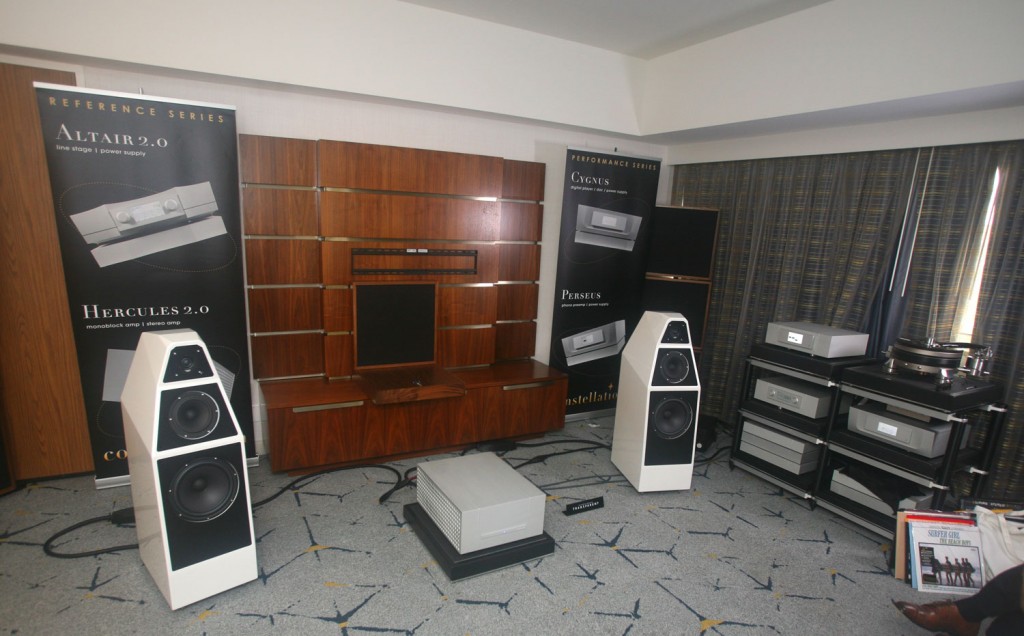
I heard Vanessa Fernandez “When the levee breaks” for the first time in the Constellation Room which made me stay to the end of the song.

Then 10 minutes later in the Prana Fidelity room [different songs, though :-). As Steven Norber (Prana Fidelity) put it, “ambitious”.
[If you can get past the fact that this is not done at ‘Robert Plant screaming each syllable like it is the last thing he will ever do’ energy levels then it can be quite entertaining]
Speaking of Robert Plant, I heard Whole Lotta Love through the wall our sleeping room shared with On a Higher Note. So later in the show I suggested to Hermann and Neli that we play music like that.
Neli smiles. Was it a humor-the-husband smile? I don’t know. Worth it if it was – I love her smiles.
Hermann, though, just looks at me. Maybe he didn’t understand me. I can talk really fast and Hermann is German. “Whole. Lotta. Love.” I wait. “Led. Zeppelin.” I wait some more. “Do they have Led Zeppelin, in Germany?”
Now, I was just trying to give him an out – he could say something like “Audiophiles don’t listen to Led Zeppelin much in Germany” and we could move on. Certainly they don’t listen to it much here in the U.S.
Here Neli chimes in “Don’t be silly. blah. blah. blah. Heavy metal.. blah. blah. blah.” [I am sure she hears me in the same ‘garbled Charlie Brown teacher-speak ‘ about 99% of the time, so I am not REALLY being disrespectful ;-)].
Anyway, it seems several minutes go by, and I hear the first few bars of Whole Lotta Love coming from our music server. So he DID know what it was and had even loaded it on the server at some point.
So he starts dancing in his chair and telling me to turn it up. And turn it up more. And more.
Finally I hand him the volume control. He makes the amp and server, let HIM blow the thing up.
The upshot is some recordings of this song are very clear, can be played very loud, and there is a lot of stuff happening in the song, more than you might think if you haven’t heard it on a great system at volume.
It has been my hypothesis for awhile, that 90 percent of audiophiles like Classical, Classic/Modern Rock, or both. The close-mic’d female vocal with 3 piece band is played by people whose stereo is not able to play much of anything else, and they decided they ‘like’ it.
Not that most of us don’t like other kinds of music, but day to day, for enjoyment, we most like the difficult stuff; complex multi-layered music, that likes to be played loud: Classical music and Rock.
Now, finally, perhaps all the remastering of the remasters of the remasters finally are turning out decent quality sound? We are investigating.
————
I used to write a lot about the sound at these shows.
But after awhile you realize that the vast majority of exhibitor’s rooms sound much the same show to show. Always engaging, or over polite, or detailed and sophisticated, or grainy, or dead, or lack micro-dynamics and subtleties and emotion, or authority, or whatever.
Later you can reliably attribute these characteristics to specific brands of gear. If they use THAT brand’s amp, then it is going to tend to have a whiteish, flatish sound. If they use this OTHER brand of amp, it is going to be dynamic but dead sounding and often has a compressed, over-bearing, ‘always loud’ sound.
This is just like seeing the size of the speaker in a room and anticipating that the small speakers will probably have less depth and authority and the very large speakers, on average, will have less delicacy.
So a person can create a database [in their head if nowhere else] of what each brand sounds like, and even what each component of the brand sounds like if one is lucky enough to have experience with many individual components. We made a stab at making this database, starting with amps, here on the blog a loooong time ago but haven’t updated it in forever.
I want to talk about this database and how it works.
So imagine a well-populated database, with lots of components [including cables and speakers, of course] and what they sound like, on average, i.e. a list of what their strengths and weaknesses tend to be.
Only one more thing is needed to be able to predict what a system will sound like: a Relationship graph. What will things sound like when component A is paired with component B, C and D [here we introduce the listening room itself as another component].
My brain is extremely lazy. Like a cat, it wants to nap all the time. If yours is anything at all like mine, one can, instead of a complex graph like this, just create another very large table of what PAIRS of things will sound like. And narrow this down to just amp-speaker pairs and some amp-preamp pairs.
There are many ways to use these relationship graph of what components sound like when pair with each other to approximate the resulting sound of the system in your head. For example, if pairing A with B sounds like S1, B and C like S2, C and D sounds like S3. and then estimate the sound by interpolating between the sounds of the pairs of pairs: of S1,S2; S2,S3 and S1,S3.
Or [for this example, we assume we do not know what the speaker-amp pair sounds like and just use the primary database] one can do weighted curve fitting, attributing the most weight to the speakers, a little less to the amps, then the kind of source, then the room, cables, preamp, the actual source component, the equipment rack / vibration control, etc. Note that knowing what the speaker-amp pair sounds like, in particular, is extremely important if you want this estimate of the sound to be as close as possible to what the sound really will be.
e.g. If we have Audio Research on Wilson with a TechDAS turntable front end, and assume we have a good deal of experience with what audio research sounds like, and Wilson, and even how the two sound together. Say we also have some experience of what TechDAS brings to the party. Then, using this approach, one can have a good deal of confidence what an exhibitor’s room that features this system will sound like. If the actual experience strays too far from our estimates, we correct the database a little – and if it strays really far, we figure out who set up the room because some people are VERY good at system setup – and it is always good to know who these people are. You know, just in case we have a setup emergency :-). [and some people are very BAD at setup, always good to know who they are too].
[FYI Robert Lee of Acoustic Zen is probably the best we have seen at room setup. Jonathan Tinn (Evolution Acoustics) and Steven Norber (Prana Fidelity) are pretty good too. Neli is good too, though I do not want this to go to her head so “No Neli, these are not the droids you are looking for.” People bad at setup? Not to mention names, but typically those renowned for their setup skills and/or charge money for setup. Yep. Strange world we live in.]
The problem with actually publicizing such a database is that manufacturers, dealers, and fans of a brand enjoy and promote the illusion that their brand’s products are perfect. And this database describes things by how they differ from perfection – how they are flawed. So rather than focusing on the usefulness of the database, they focus on what the database says about their particular favorites. This makes them unhappy – and the number of these unhappy people, who believe ‘my components are perfect’ vastly outnumber those who want to understand the truth of things.
So, anyway. At a show, things pretty much sound like they are supposed to sound like, given the components of the system and the particular room’s compromises. It is only the standouts, the surprises, that make the show interesting [for example, the sound in our room was remarkably coherent and stable for show conditions, especially given the ductwork overhangs and mirror on one side and padded headboard on the other side. I tentatively attribute this to the symmetry of the duct work, fairly substantial walls, and ‘setup luck’].
To make shows truly exciting we would have to bring the Mixibitors out of retirement. They let us showgoers specify the components in each exhibitors room, not leaving this important decision up to the poor exhibitors. Typically the mixibitors operate in the wee hours of the night, moving things from room to room, setting up awesome systems for us to hear for a few hours. They then put everything back where it was before the exhibitors wake up and return to their exhibit rooms to reopen the show the next morning.
Say we tell them to start with Wilson Alexandria II speakers. What amp would we all like to hear on them? A small 2A3 SET amp in a small [but not too small] room? Along the long wall in a 15 x 12 foot room maybe? Well the rooms were a standard 18 x 13, so that will have to do. What preamp? Maybe the Lamm LL1 as it is very clean and won’t tarnish the purity of the lovely 2A3 tubes? Source? Vinyl probably. Something very detailed and neutral like the Walker? Or crazy lively like the Audio Note TT2? You choose.
But shows are not like this anymore . At least not in the U.S. The mixibitors are retired. And the systems setup by exhibitors are composed of safe, best sellers or brands that someone who contributed to the room’s costs wants to promote. They are not chosen for the best sound or even interesting sound.
Ergo. Not much to write about with respect to the sound at the show. 🙂
[I realize there is, however, a great deal of usefulness in a description of each room and its sound and how it differs from perfection for some showgoers who want to understand more about what they heard and how it differs from what someone else heard. A report that can help them put things into context. For this they need a detailed, honest accounting. Though we, in the past, have tried to provide such an accounting, it is a thankless task [see above re: the database]. Reports with just photos, on the other hand, are enjoyed by just about everybody [though they are starting to pop up everywhere now and their value is commensurately diminished. Putting our photos on Cheers helps differentiate our reports – making them realtime parties], don’t require us to upset a lot of people [like our honest depictions do] and don’t require us to lie by omission [like the common ‘feel good’ reports out there do]].
Still, it is great to see everybody, and update the database with new components and their list of how they differ from perfection. And add minor corrections of the others already in the database . A lot of these updates are gratifying as many brands have steadily improved. In fact. the vast majority has improved quite a bit since we started this business 15 years ago. Things we did not like, back in the day, for – in our opinion – being far below the performance curve of their competition are at least average if not better than average now. And the performance curve keeps going up [Yay!].
Another Spring. Another Newport | Irvine | LA Audio Show.
I love Spring.
Next, Summer! and California Audio Show CAS 2017.
Hope to see you all there!
LA Audio Show Report 2017 in 5 Minutes or less. A more wordy report is in the works.
The show was about 2/3 the size of last year’s Newport (actually in Irvine) show, about 110 rooms, with fewer attendees. At this point only stalwarts exhibit at these shows and people were optimistic about next year, especially if a better hotel / location can be found.
Each show sounds better than the last, IMO, and no one embarrassed themselves too much. We were very happy with our sound.
No one tried to break new ground at the tippy-top of the audio performance spectrum which is becoming less and less common, and was always rare outside of CES, which is itself dying high-end audio-wise. So… kind of sucks to be really picky at these shows.
We posted photos live on our LA Audio Show Party which allowed people to comment and suggest additional photos in real-time. I will be adding a few final photos there to finish coverage of the 108 or so rooms I was able to get to at the show.
[cover photo] Danny Kaey [ post your meme in the comments ;-} ] … Tries to save me from the addictive pleasures of the Einstein / TechDAS room.
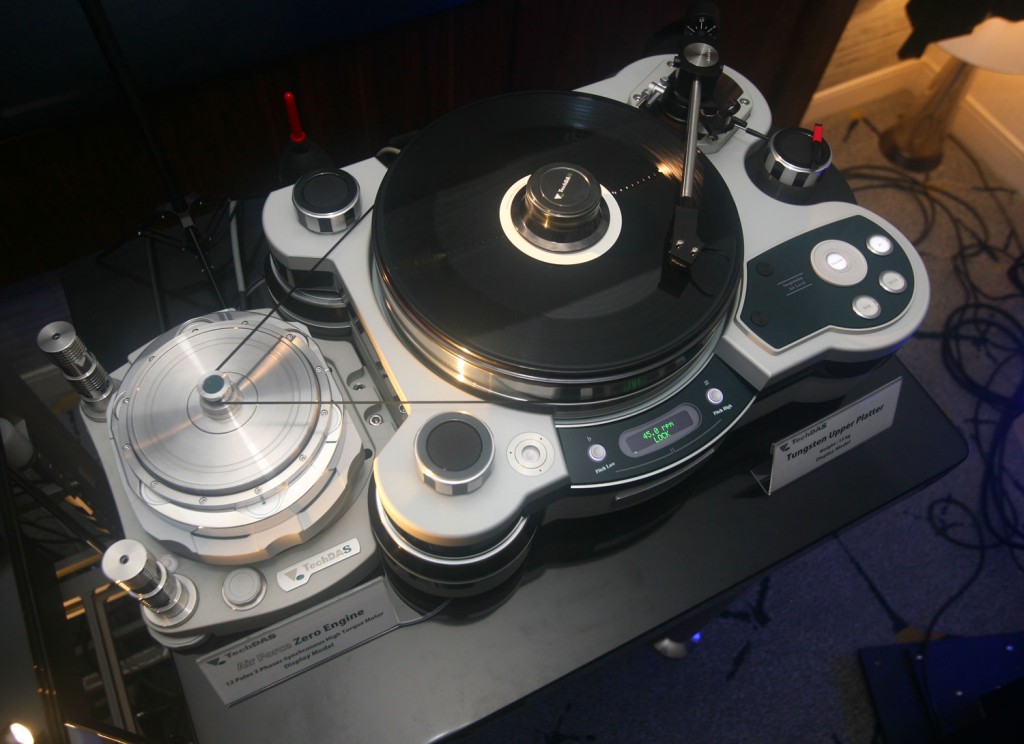
But he was unsuccessful [the TechDAS Air Force One turntable in the Einstein room].
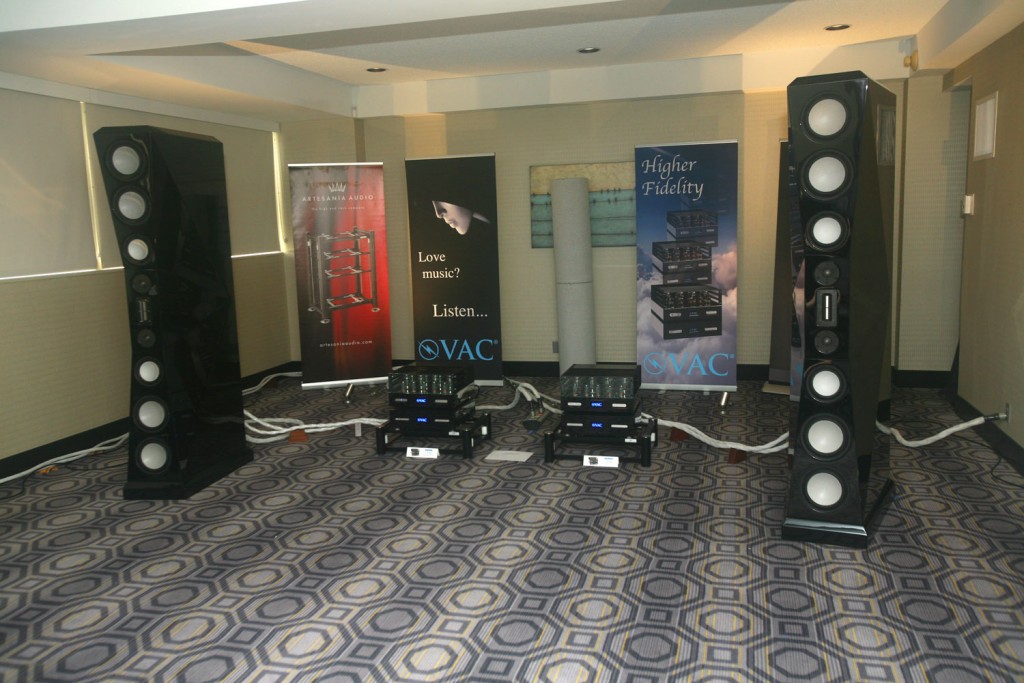
Von Schweikert brought some very large speakers.
A number of small speakers were sounding good…

Evolution Acoustics debuted some new speakers
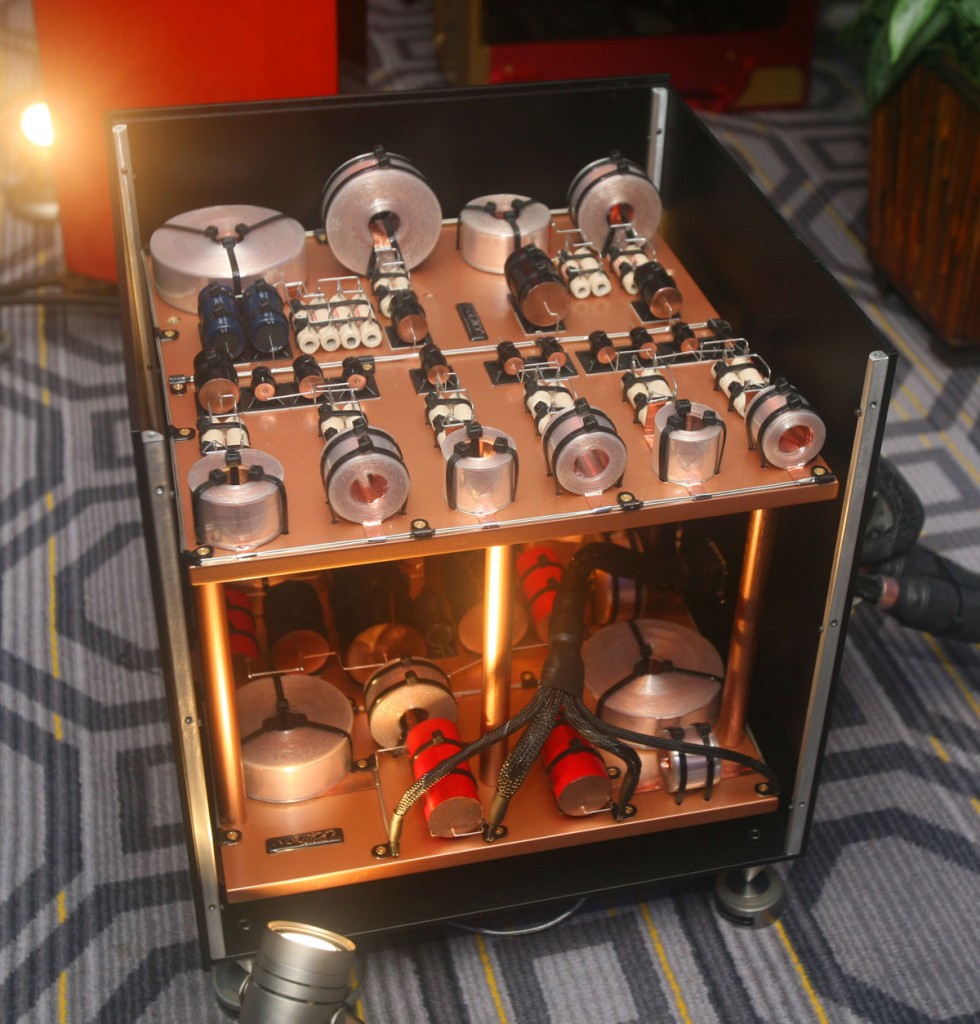
With a huge, awe inspiring crossover [again]
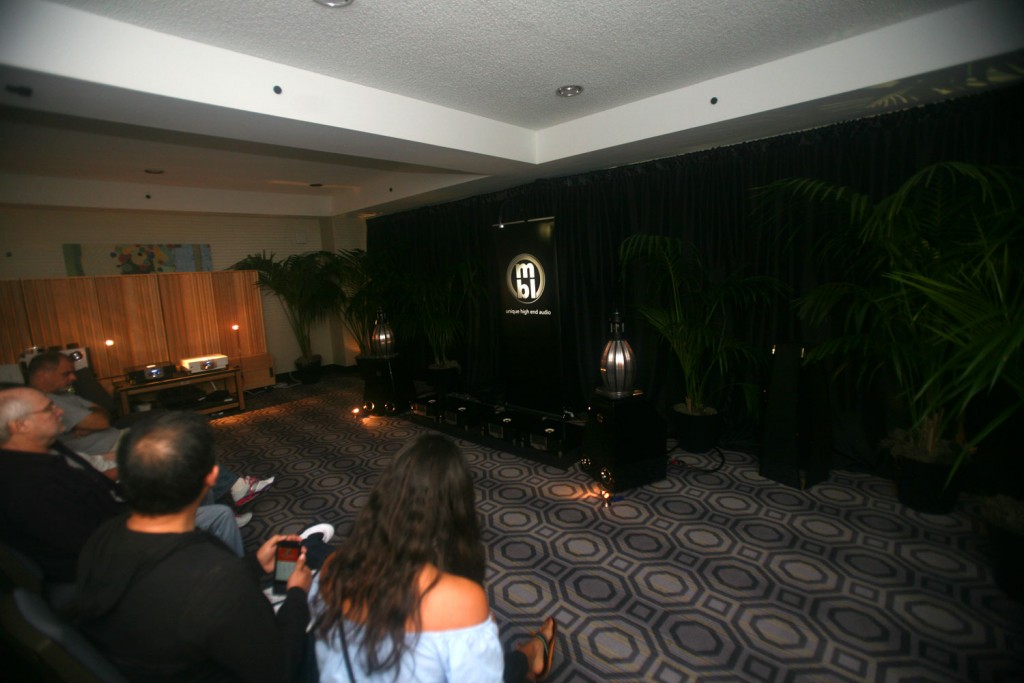
MBL won the darkest room competition… again… [and was perhaps the most popular room, it was frequently busy here]
Neli (and Hermann Winters – Acapella audio arts) took care of the exhibit room while I got to go outside and play.
Many women these days are in high-end audio, but often behind the scenes, if not, in fact, running the companies [like Neli does Audio Federation :-)] so us boys can play with our toys: Lucy (Acapella), Annette (Einstein), Kelly (Prana Fidelity), Melissa (Clarity Cable – just a attendee this year), Bea (VTL), Eneke (Vandersteen), Pandora (On a Higher Note), Samira (HighEndZone), Terry (AVShowReports) Marjorie (the RMAF show) and Marine (runs this LA Audio Show) and many more who were not here at the show this year [deepest apologies to other women who were here and should also be on this list].
A.J. Conti (Basis turntables) passed away unexpectedly recently, and his final design debuted in the Vandersteen / HRS room [more photos forthcoming]. His wife is continuing the business [not a surprise, based on all the women running things in the preceding paragraph].
The show, as much as anything else, allowed people to get together and plan how they will try to take the consumer electronics world back from the lo-fi barbarian hordes [or just complain a lot. or just blame it all, from MP3 to the lack of innovative music being produced today, on your innocent friendly neighborhood photographer, as Danny is doing at the top of this post:-) ].
Wilson dominated the speakers choice made by exhibitors, being present in the Cardas, Boulder, Constellation, Grand Prix Audio, Wilson Audio, and Audio Research rooms

New products were introduced. Here we see the new Vivid “Giya G1 Spirit” loudspeaker. [Our sleeping room bed was on the other side of that wall there. Sounded good to us! 🙂 ]
About 40% of the rooms have a turntable, like this Kronos table, which was in 2 or 3 rooms [see our photo gallery of the 40 to 50 turntables at the show on our page on Instagram].
Turntables may now outnumber CD players at shows as more and more people switch to the turntable | music server combination as their only sources
High End Zone showed Starke Sound’s massive 30 [or so] channel audio / video setup and a 20-channel [or so] setup in a different room. Each channel was reproached with a fullrange-ish speaker.
Sorry about the quality of some of the photos – low light conditions, part-time none-too-bright photographer, etc. etc.
The sweet spot. Our room.
The next show is the California Audio Show July 28-30 in Oakland. Now that we are in Palo Alto, this is our local show. See you there!
Photos of Floors 5 and 3 of the LA Audio show, about about half of the show was posted Live on the Cheers La Audio Show 2017 party yesterday afternoon.
Some people seem like they may have had some problems, but most have not. 🙂
The second half will hopefully go up today. on Cheers Then choice high-res photos on Sunday. Sound good?